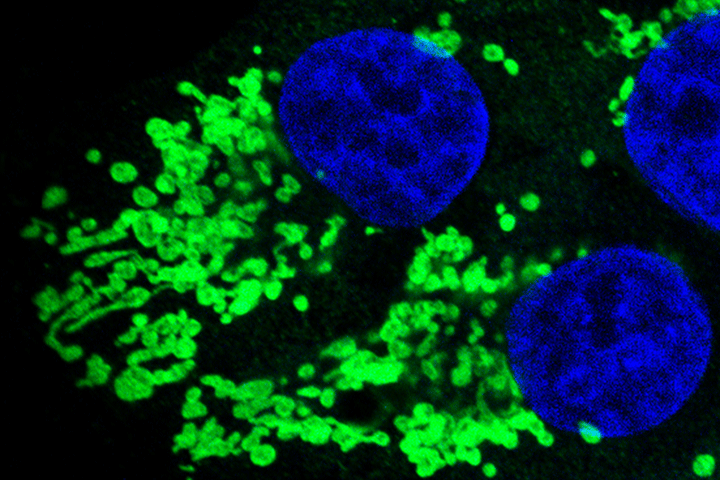AACR Virtual Special Conference on Pancreatic Cancer: Day Two Highlights

Imagine a scenario in which doctors can predict more accurately which treatment strategies for each pancreatic cancer patient may work best based on individual variability in genes, among other factors.
Also imagine a scenario in which pancreatic cancer can be detected earlier, a time in which the disease is more amenable to treatment. These themes were highlighted in the opening plenary session of the second day of the AACR Special Conference on Pancreatic Cancer. The session chair was Dr. Andrew V. Biankin of the Wolfson Wohl Cancer Research Centre at the University of Glasgow.
Plenary Session 3: Precision Medicine and Early Detection
An exception to the rule—a coding functional variant at a pancreatic cancer GWAS locus: Dr. Laufey T. Amundadottir of the National Cancer Institute (Bethesda, Maryland) stated that 20 pancreatic cancer risk loci have been identified by GWAS in European populations. GWAS stands for genome-wide association study. These observational studies look at a genome-wide set of gene variants in many different individuals to figure out if any variant is associated with a trait. Chromosomes are pieces of coiled DNA. They contain many individual genes, which are segments of DNA carrying instructions for making proteins. Those genes work together to make a cell viable. Locus or loci is a term scientists use for the exact place where a gene is located on a chromosome. Some scientists liken it to a street address. According to Amundadottir, research shows the majority of pancreatic cancer risk loci are located in non-coding areas; 11 loci have been identified in TWAS, or transcriptome-wide association studies. TWAS aggregates genomic information into relevant units that map to genes and their expression. Researchers are focusing on one specific variant associated with pancreatic cancer, which is located near two chymotrypsin genes, which are responsible for several biological functions, including the digestion of proteins.
Precision oncology for pancreatic cancer: Biankin led this session discussing the increase in the number of therapies available for pancreatic cancer over the past two decades. Although there have been some incremental benefits, what’s clear is there is much room for improvement, especially when it comes to picking the right therapy for the right patient, or precision medicine. To get to that next level, researchers have developed the Precision-Panc clinical trial platform. The Precision-Panc platform was founded in 2017, bringing together expertise in pancreatic cancer from the University of Glasgow, Cancer Research UK (CRUK) Beatson Institute, CRUK Cambridge Institute, CRUK Manchester Institute, The Institute of Cancer Research, London, the University of Oxford, and the National Health Service (NHS), UK. There is wide network of hospitals that can offer precision medicine clinical trials to patients with pancreatic cancer. Researchers are still trying to understand how to use current treatments more advantageously for each patient, and are looking to understand how pancreatic cancer evolves over time and with treatment. What is clear is that treatment needs to be adjusted to a patient’s ever-changing disease to get the best possible outcomes while avoiding overtreatment. There is also a need to accelerate therapeutic development. All patients with Precision-Panc have gene testing through the Glasgow Precision Oncology Laboratory, with an affordable gene test called the Glasgow Cancer Tests. The genetic report allows for recruitment into precision medicine clinical trials, and informs clinical decision- making with a patient’s physician. The goal of the program is to link discovery research, preclinical research, and clinical research to improve upon the use of current therapies and to develop new treatment regimens.
Molecularly targeted imaging and treatment via the integrin αvβ6: Imagine a dose of a radioactive drug so precise it targets only pancreatic cancer while leaving healthy cells alone. Dr. Julie L. Sutcliffe and her team at UC Davis Health (Sacramento, California) have been working on the development of a radiotracer that binds only to tumor cells—in this case integrin αvβ6 (alpha v beta 6). Integrin αvβ6 is found on the surface of pancreatic cancer cells as well as other cancers and belongs to a family of proteins called integrins. The team has already demonstrated the ability to use this particular integrin target to image pancreatic cancer tumors and metastatic lesions in the liver and lung. So far, the first-in-human studies for this imaging are almost completed; they have been well tolerated, and the team is now adapting this imaging agent to deliver radioactive drugs to kill the tumors. The approach is dubbed “theranostics,” which is a combination of the terms therapeutics and diagnostics—basically using one radioactive drug to diagnose and a second to deliver precise treatment.
Understanding inherited risk for pancreatic cancer: Dr. Alison P. Klein, from Johns Hopkins Sidney Kimmel Comprehensive Cancer Center, Baltimore, Maryland, provided an overview of inherited risk statistics. According to research, having one close relative with pancreas cancer increases risk 2.14 fold; two close relatives yields a 6.79 fold increase, and three or more close relatives increased risk 17.02 fold—and it is at that point where researchers are focusing screening efforts. Common mutations are about two times more frequent in high-risk families, and families with IPMNs (a type of pancreatic cyst) also have a higher frequency of common germline (inherited) mutations. Doctors encourage germline testing for all pancreatic cancer patients, which is now recommended in guidelines. This provides better access to targeted therapies for some mutations, and there are important implications for screening for other cancers in these individuals as well.
Plenary Session 4: Metabolism and Homeostasis
The next plenary session dealt with some highly technical work being done in the area of metabolism—how a cancer cell gets energy—and homeostasis, a cell’s ability to make constant adjustments to keep itself stable while conditions change inside and outside of the cell.
Metabolic networks in the tumor microenvironment: Dr. Costas A. Lyssiotis (University of Michigan, Ann Arbor) spoke about the metabolic interactions in tumor microenvironment and how cells are both cooperative in sharing resources and eliminating waste, as well as competitive in keeping the antitumor immune system at bay. Blocking these efforts should, in theory, enhance tumor destruction.
Metabolic adaptations in pancreatic cancer: Dr. Kathryn E. Wellen, University of Pennsylvania Perelman School of Medicine, Philadelphia, spoke about the hexosamine biosynthetic pathway as a vulnerability for pancreatic cancer.
Mechanisms of pancreatic cancer-induced cachexia: For patients and their families, one of the most difficult aspects of pancreatic cancer is cachexia, the massive loss of weight and muscle. Dr. Denis C. Guttridge (Medical University of South Carolina, Charleston) cited research showing that certain secreted factors from a pancreas tumor signal the brain to promote a state of anorexia while other signals go to the fat and muscle cells and promote their breakdown. Pancreas cancer has the highest incidence of cachexia even at its earliest stages. Patients lose on average 14 percent of body weight. Maintaining weight is not only important for quality of life, but for outcomes; patients that lose more than 10 percent of their body weight have worse outcomes compared to those that lose less. Researchers are looking at the various mechanism of communication between tumor and muscle and are trying to determine the pathways of muscle loss. They have already identified a defect in recruitment of muscle stem cells and muscle repair mechanisms, which is driven by an inflammatory pathway. The team is looking to identify and validate pathways that can be targeted therapeutically to prevent muscle loss.
Epithelial cell plasticity in pancreatic cancer: The function and fate of metaplastic tuft cells: Dr. Howard C. Crawford (University of Michigan, Ann Arbor) spoke about the plasticity of pancreas cells and how researchers are working to understand the pathways that drive pancreas cells to change fate. This work focuses on acinar-to-ductal metaplasia and the generation of a particular type of cell called a tuft cell. These cells resemble taste buds and express some of the same genes used in taste reception. When they deleted one of the taste receptor genes from these cells in mice, the mice had an accelerated progression from benign neoplasia to pancreatic cancer. They are working to better understand this process in the hopes of understanding the earliest stages of development of pancreatic cancer.
Abstracts Discussion
Numerous abstracts were presented in this session chaired by Dr. Elizabeth M. Jaffee of Johns Hopkins Sidney Kimmel Comprehensive Cancer Center. In one abstract, Dr. Hannah L. Williams, of the lab of Dr. Brian Wolpin of the Dana-Farber Cancer Institute (Boston), showed that single-cell analysis reveals that there are tumors that have both the classical and basal-like features, as well as individual cells that contain both features. Data suggests that patients with the mixed phenotypes have the worst outcomes, suggesting that the instability or plasticity might be the feature researchers want to track in the future. Dr. Ying Liu, out of Dr. Brian Haab’s lab at the Van Andel Institute, Grand Rapids, Michigan, is looking at a new potential biomarker that can be used with CA 19-9 to better diagnose or get a better prognosis for pancreatic cancer. This biomarker is currently being validated with clinical samples in multiple labs.
Closing Keynote and Remarks
The two-day event ended with a discussion about the state of immune treatment in pancreas cancer and a discussion about team science approaches.
Dr. Vinod P. Balachandran of Memorial Sloan Kettering Cancer Center (New York) discussed the current state of play in immune-oncology. One major challenge is to figure out why about 80% of tumors do not respond to current immune strategies. Researchers believe if they can use pancreas cancer as a prototypical “cold” tumor that does not respond, and figure out how to get it to respond to immune therapies, there will be a significant benefit in the treatment of pancreatic cancer and other cancers. Balachandran’s team is getting at this problem by learning from long-term survivors. These survivors are key to learning how to apply the mechanisms that allow these individuals to do well to therapies that can be applied to the majority of pancreas cancer patients. These studies are showing differences in the immune systems in longer-term survivors—better response to neoantigens and presence of different immune cells in the tumors—and these observations are being applied in an ongoing clinical study to see if these benefits can be extended to other patients.
Dr. Steven D. Leach of the Norris Cotton Cancer Center, Hanover, New Hampshire, talked about team science as a continuum—from investigator-initiated science to collaboration to integrated interdisciplinary teams. The pancreas cancer research community is uniquely well-suited for a team science approach, with examples such as large-scale genomic efforts, the Pancreatic Cancer Collective and PanCAN’s Precision Promise initiative. That team approach will ultimately benefit pancreatic cancer patients.






